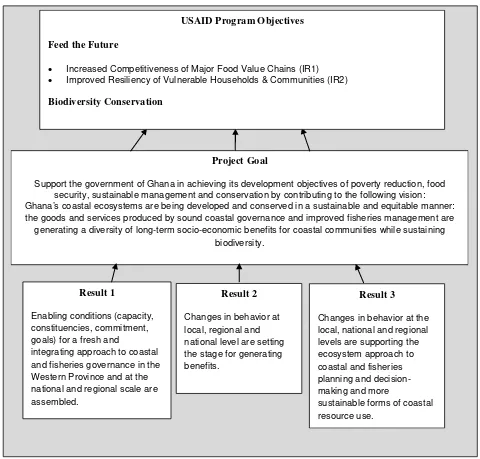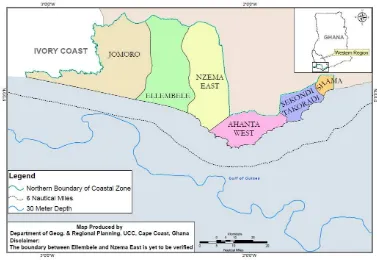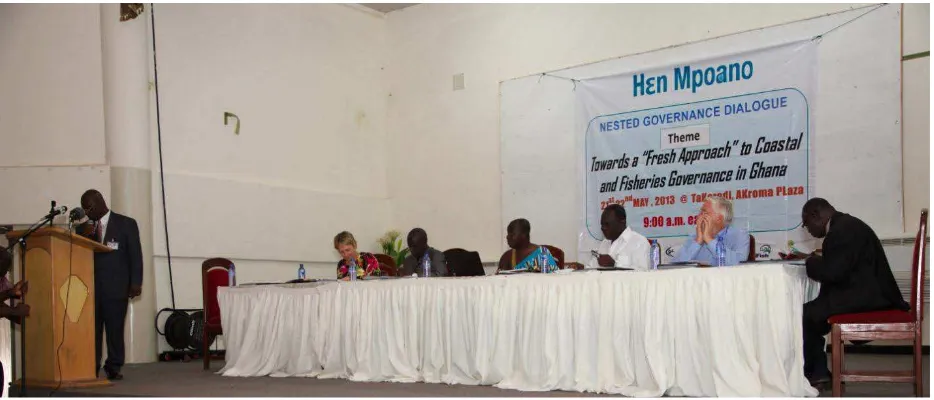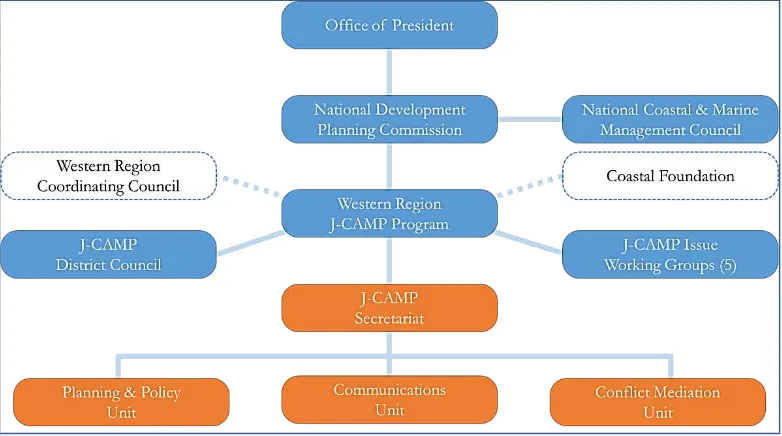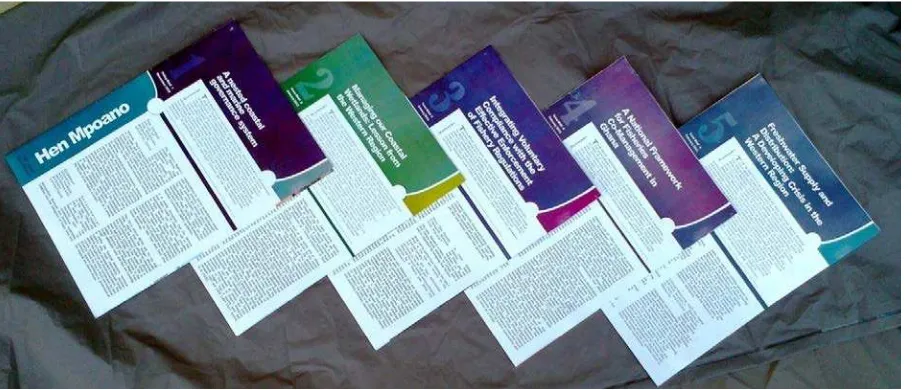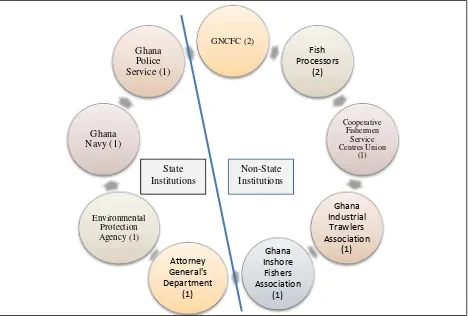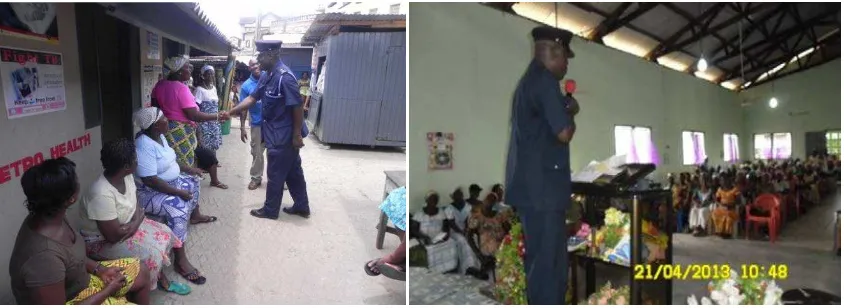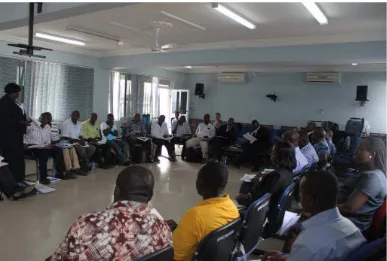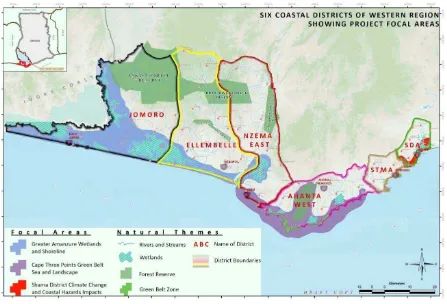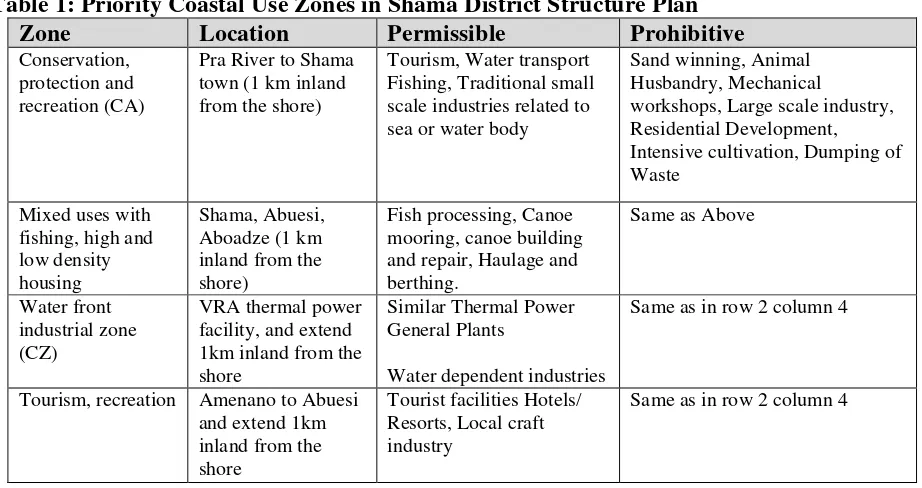Integrated Coastal and Fisheries Governance (ICFG)
Initiative for the Western Region of Ghana
HƐN MPOANO (OUR COAST)
Annual Report 2013
October 1, 2012 – September 13, 2013
Cooperative Agreement No. 641-A-00-09-00036-00
This publication is available electronically on the Coastal Resources Center’s website at http://www.crc.uri.edu
For more information contact: Coastal Resources Center, University of Rhode Island, Narragansett Bay Campus, South Ferry Road, Narragansett, Rhode Island 02882, USA. Brian Crawford, Director International Programs at Email: [email protected]; Tel: 401-874-6224; Fax: 401-874-6920
Citation: 52) Coastal Resources Center. (2013). The Integrated Coastal and Fisheries Governance (ICFG) Program for the Western Region of Ghana, Year 4 Annual Report, 2013. October 1, 2012 to September 30, 2013. Narragansett, RI: Coastal Resources Center, Graduate School of Oceanography, University of Rhode Island. PW013. 69 pp.
Disclaimer: This publication is made possible by the generous support of the American people through the United States Agency for International Development (USAID)/Ghana. The contents of this report are the responsibility of the Integrated Coastal and Fisheries Governance (ICFG) Program and do not necessarily reflect the views of the United States Government. Associate Cooperative Agreement No. 641-A-00-09-00036-00 for “Integrated Coastal and Fisheries Governance (ICFG) Program for the Western Region of Ghana”.
Cover Photo: Fishmongers buying fish from a canoe
List of Key Project Contacts
Coastal Resources Center, URI Tel: 401-874-6488
Fax: 401-789-4670
Email: [email protected]
Brian Crawford
Director, International Programs Coastal Resources Center, URI Tel: 401-874-6225
Fax: 401-789-4670 Email: [email protected] Web: www.crc.uri.edu
Don Robadue
Coastal Resources Center, URI Tel: 401-874-6128
Friends of the Nation –Ghana Tel: +233 (0) 244 520 686
Director, Economic Growth Office USAID / Ghana
Email: [email protected]
Robert Buzzard Senior NRM Advisor,
Team Lead: Energy, Environment and Natural Resources Management, U.S. Agency for International Development/Ghana
Senior Acquisition & Assistance Specialist (Accra/WA/SAAS)
Tel: 0302 742720
List of Acronyms
AFRICOM United State Africa Command A-G Attorney-General
AO Agreement Officer
AOR Agreement Officer Representative AWG Amanzule Working Group
BCS Behavior Change Support
BUSAC Business Sector Advocacy Challenge C3P Cape Three Points
CAFA Civil Society Alliance for Fisheries Agenda CBAG Community Biodiversity Advisory Group CBD Community-Based Distributors
CB-FMC Community-Based Fishery Management Committee CBO Community Based Organization
CCM Center for Coastal Management CDI Carbon Decision International
CEC Community Environmental Committees
CEMAG Community Environmental Monitoring & Advocacy Group CEWEFIA Central and Western Fishmongers Improvement Association CHF Community Housing Foundation
COLANDEF Community Land Development Foundation CRC Coastal Resources Center
CREMA Community Resource Management Areas CSOs Civil Society Organizations
CSPG Cross Sectoral Planning Group CSR Corporate Social Responsibility CWOW Citizen Watch on Water
DCOP Deputy Commissioner of Police
DFID Department for International Development DQA Data Quality Assessment
EBM Ecosystem-Based Management
ECHNTS Essiama Community Health Nurses Training School EIA Environmental Impact Assessment
EPA Environmental Protection Agency ESS&F Ecosystem Services and Functions
FAO Food and Agricultural Organization (of the United Nations) FC Forestry Commission
FGEF French Global Environmental Facility FOAT Functional Operational Assessment Tools FoN Friends of the Nation
FTF Feed the Future
FWG Fisheries Working Group GCC Guinea Current Commission
GCC-SL Global Climate Change – Sustainable Landscapes Program GCLME Guinea Current Large Marine Ecosystem
GES Ghana Education Service GHS Ghana Health Services
GNCFC Ghana National Canoe Fishermen Council GoG Government of Ghana
GPSMU Ghana Police Service Marine Unit HKN Health Keepers Network
ICFG Integrated Coastal and Fisheries Governance ICM Integrated Coastal Management
ICT Information and Communication Technology IEC Information, Education and Communication INBAR International Network of Bamboo and Rattan IUCN International Union for the Conservation of Nature JCAMP Joint Coastal Area Management Planning
LCA Leadership for Conservation in Africa LGU Local Government Unit
LI Legislative Instrument
LOGODEP Local Government Decentralization Program LME Large Marine Ecosystem
LUPMIS Land Use Planning and Management Information Systems LUPMP Land Use Planning and Management Project
M&E Monitoring and Evaluation
MCS Monitoring Control and Surveillance
MCMC Marine and Coastal Management Committee MDA Ministries, Departments and Agencies
METSS Monitoring and Evaluation Technical Support Services
MESTI Ministry of Environment Science and Technology and Innovation MLGRD Ministry of Local Government and Rural Development
MoFA Ministry of Food and Agriculture MoU Memorandum of Understanding MPA Marine Protected Area
MTDP Medium Term Development Plans
NADMO National Disaster Management Organization NDPC National Development Planning Commission NGO Non-Governmental Organization
NORAD Norwegian Agency for Development NSP National Service Volunteers
OIC Opportunities Industrialization Center
OLIVES Organization for Livelihood Enhancement Services PCC Platform for Coastal Communities
PCV Peace Corps Volunteer
PDD Project Description Document
PFPI PATH Foundation Philippines Incorporated PHE Population Health and Environment
PIN Project Idea Note
PMP Performance Monitoring Plan PMR Performance Monitoring Reports PMU Program Management Unit RCC Regional Coordinating Council
REDD Reducing Emissions from Deforestation and Forest Degradation SDF Spatial Development Framework
SOP Standard Operating Procedures SPAG Spatial Planning Advisory Groups SpD Spatial Dimensions
STAR-Ghana Strengthening Transparency, Accountability and Responsiveness in Ghana STMA Sekondi-Takoradi Metropolitan Assembly
TCPD Town and Country Planning Department UCC University of Cape Coast
UG University of Ghana - Accra
UK United Kingdom
URI University of Rhode Island USA United States of America
USAID United States Agency for International Development WAPCA West African Primate Conservation Action
WARFP West Africa Regional Fisheries Program (World Bank funded)
WERENGO Western Region Development Network of Non-Governmental Organizations
WR Western Region
WRCC Western Regional Coordinating Council
Contents
List of Key Project Contacts ... ii
List of Acronyms ... iii
Contents ... vi
List of Figures ... vii
List of Boxes... viii
Executive Summary ...1
Introduction ...1
1.0 Designing Options for Nested Integrated Coastal and Fisheries Governance Systems ...5
1.1 Options for a Nested Coastal Governance System for the Western Region ... 5
1.1.1 Working Paper on Joint Coastal Area Management Planning...6
1.1.2 Issues Briefs ...6
1.1.3 Collaboration and Sustaining Momentum with other Initiatives ...7
1.1.4 GIS and Spatial Planning Capacity for Regional and District ICM ...8
1.2 Developing Nested Fisheries Governance in the Western Region ... 8
1.2.1 Fisheries Co-management Legislative Initiative ...9
1.2.2 Strengthening the capacity of stakeholders for compliance and enforcement ...13
2.0 Improved Coastal Governance at the District and Coastal Settlements ...15
2.1 Shama Focal Area ...15
2.1.1 District Level Coastal Management...15
2.1.2 Anankwari Floodplain and Pra River Estuary ...16
2.1.3 Shama Shorefront Management ...17
2.1.4 Livelihood Resilience and Adaptive Capacity for Anlo Beach ...17
2.2 Greater Cape Three Points ...19
2.2.1 District Level Coastal Management...20
2.2.2 Conservation of Critical Sea and Landscape Habitats ...22
2.2.3 Akwidaa and Dixcove Fish Landing Sites Livelihood Resilience ...24
2.3 Greater Amanzule ...25
2.3.1 District Level Coastal Management...26
2.3.2 Conservation of Greater Amanzule Wetlands ...26
3. Communications and Documenting Lessons Learned ...30
3.1 Communication and Liaison between Regional and National Scales ... 30
3.2 Communications at the Local and Regional and National Scale ... 30
3.3 Capstone Document ... 31
4. Program Management ...34
4.2 Strategic Partners, Clients and Collaboration ... 34
4.2.1 New Opportunities ...35
4.3 Monitoring, Evaluation, Performance Management and Reporting ... 35
5.0 Project Closeout ...37
Annex A: ICFG M&E Indicator Reporting to USAID ...39
Annex B: Customized Governance Scorecard for the ICFG Initiative ...40
Annex C: Results to Date (FY10-FY13, September, 2013) ...43
List of Figures
Figure 1: USAID Program Objectives and the Results Framework of the ICFG Initiative ... 2Figure 2: Map of the six focal districts of the Western Region and the adjoining seascape ... 3
Figure 3: Dignitaries at the Nested Governance Dialogue ... 5
Figure 4: Proposed Structure for the Joint Coastal Management Area ... 6
Figure 5: Five of the published issue briefs ... 7
Figure 6: Fisheries Working Group with membership representation in brackets ... 12
Figure 7: Marine Police interacting with women (left) and a church congregation (right) ... 13
Figure 8: Experience sharing by actors in the prosecution chain ... 14
Figure 9: Map of Six Coastal Districts showing ICFG Focal Area ... 15
Figure 10: Beneficiaries of training at graduation ceremony ... 18
Figure 11: A Green Belt Map for the Cape Three Points Focal Area... 20
Figure 12: Members of Marine and Coastal Management Committee (MCMC) deliberating at a field visit... 21
Figure 13: CREMA areas around Cape Three Points Forest Reserve ... 23
Figure 14: A near complete Akwidaa Market donated by USAID and the ICFG Initiative ... 24
Figure 16: Production of trashy bags from sachet water plastics (left) and (right) women displaying trashy bags ... 25
Figure 17: Map of the Amanzule study area in the Western Region of Ghana ... 28
Figure 18: Land cover map (2012) of the Amanzule wetland complex. The classified image was developed using RapidEye© imagery with a ground resolution of 5 meters. ... 29
List of Boxes
Box 1: Conclusions from analysis of current framework and legal basis for fisheries
co-management in Ghana... 10
Box 2: Key conclusions from 3rd fisheries dialogue ... 11
Box 3: Highlights of ICM policies extracted from spatial plan ... 17
Box 4: Highlights from PHE Lessons Learned Document ... 19
Box 5: Coastal management policies in Ahanta West Spatial Development Framework ... 22
Executive Summary
This is the fourth and final Annual Report of the USAID funded Integrated Coastal and Fisheries Governance (ICFG) Program (popularly called Hɛn Mpoano) in the Western Region of Ghana. The four year (2009-2013) program was designed to assemble the enabling conditions for ‘a fresh approach’ to coastal and fisheries governance in Ghana. The program was carried out in three phases.
Phase I provided the context for understanding the governance arrangement and mechanisms of the place, building trust, respect and a supportive constituency (social capital). This was achieved largely through intense engagements (studies, listening and learning and
participation) with the coastal communities and local institutions (governmental and
nongovernmental); as well as some early actions in the form of small grants support for some identified institutions.
Capacity building through various mechanisms including: local and international studies tours; formation of Working Groups, rural radio drama; engagement with regional institutions eg. ICFG Advisory Council, universities, other state and non-state institutions including traditional authorities and private sector entities in the Western Region and at the national level was the thrust of Phase II.
The final phase of the Program was used to consolidate the gains as well as fashioning out exit strategies through focused communication with relevant national level institutions to ensure that the outcomes of the ICFG experiment in the Western Region feed into national policy discourse.
At the National Level, the ICFG program results were communicated aggressively to government ministries, departments and agencies as well as policy makers and top government appointees for their buy-in. Two high profile national dialogues in 2013 (3rd Fisheries Dialogue and Roundtable Discussion Coastal Planning and Governance) and
recommendations therefrom, amply demonstrated the level of buy-in into the ICFG outputs at the national level.
The results of Initiative were widely publicized through a series of issue briefs (six in all) in the Daily Graphic newspaper which has nationwide circulation. The publications drew interesting comments and suggestions for scale up into other coastal regions. The issues briefs were repackage, printed and circulated to offices, hotels and libraries, universities and schools and other public places.
This extensive public consultations and outreach culminated in the drafting of two proposals which target governance reforms (one on fisheries and the other on coastal planning and management) in Ghana. These will be submitted by the close of the ICFG Initiative to the Government of Ghana for consideration and adoption the Government.
The Ghana National Canoe Fishermen’s Council (GNCFC) as well as the Western Region Fisheries Working Group continued dialogues to improve fisheries governance in the regions. The GNCFC through the ICFG was reconstituted and for the first time allowed women to be represented on the Council. Fishmongers were also mobilized to form beach level as well as district associations to improve their voice relative to decision making at all levels. Similarly, the Fisheries Working Group, a creation of the ICFG, continued to provide a platform for dialogue on governance issues within the fisheries sector. The FWG is seen as an important body bridging the gap between state regulators and resource users in the fisheries industry. As an exit strategy of the ICFG Initiative, the group has considered rotating institutional hosting of meetings as a shared responsibility. The FWG made overture to the Fisheries Commission and the Ministry of Fisheries and Aquaculture Development for continued support after the exit of the ICFG.
At the District level, actions in the focal areas (Shama, Greater Cape Three Points and Greater Amanzule) were aimed at improving district government capacity for the practice of integrated coastal management. Activities focused on the development of model policies and processes for incorporating ICM into spatial and medium term development plans. To ensure sustainability of ICFG support, tool kits that summarize ICM information for each district were being compiled to serve as input into the next round of Medium-Term Development Plans and as guidance for future coastal planning and decision making.
In the Shama District, bylaws for management of the Anankwari river and estuary, Pra river estuary and the Shama shore front development were completed for adoption by the
Assembly.
For improved management of the Cape Three Points forest reserve, floral, faunal and socio-economic studies were completed for the development of a new management plan for the reserve. To curb illegal activities in the reserve, community monitoring teams (CMT) were trained in monitoring techniques and have received long term leveraged funds from Tullow Oil to support their activities. Also, action plans were implemented to support restoration of CREMA wetlands in the Ahanta West District while two communities (Dixcove and
Akwidaa) received support for livelihood activities.
In the Greater Amanzule focal Area, feasibility studies were completed on carbon stocks in the wetlands for potential access to REDD mechanisms. Based on the conclusions and recommendations of the studies, the thrust shifted to community conservation or ‘plan vivo’. A memorandum of agreement between the traditional authorities (Nzema Manle Council), community representatives and the three district assemblies (Jomoro, Ellembelle and Nzema East) was signed in respect of community conservation of the Amanzule wetlands.
Capstone and final Program Reporting
A Capstone document which discusses the path forward and sustainability has been drafted and will be completed and circulated during the extended no cost phase of the program. It will highlight major successes, shortcomings and difficulties encountered as well as lessons learned and recommendations for sustaining ongoing activities. The document will place the ICFG program in the context of Ghana’s coastal and fisheries governance challenges, and summarize the design and strategy of the initiative. Further, it will make recommendations for Ghana, USAID and other donors and offer insights aimed, as well, at the international communities of practice in fisheries and coastal management.
Closeout
The ICFG Initiative thus applied for and received the approval from USAID for a no cost extension to allow for a smooth completion and closeout of the Program. The original program completion date was 14 September 2013 and with the no cost extension, the program will close out on 14 January 2014.
The program began to initiate closeout processes in June of 2013. Field based, notice of the project end and some employment contracts and sub-contracts were terminated by July 31, 2013 with only a core staff remaining for closeout actions. As a result of the approval for a no cost extension, a detailed close out plan will be developed and submitted to USAID by
Introduction
In September 2009, USAID/Ghana and Coastal Resources Center (CRC) of University of Rhode Island (URI), USA signed a cooperative agreement for the implementation of the
Integrated Coastal and Fisheries Governance (ICFG) Program in the Western Region of Ghana. This program was planned for a 4-year period ending September 14, 2013 with an estimated funding of US$10 million and estimated match funding support of US $2.5 million to be provided by the implementing partners. The ICFG1 Program locally known as “Hɛn Mpoano” was designed to contribute to the long-term vision that:
Ghana’s coastal and marine ecosystems are being developed and conserved in a sustainable manner - the goods and services produced by coastal ecosystems and fisheries are generating a diversity of long term socio-economic benefits for coastal communities while sustaining biodiversity.
Key results articulated in the design were organized around CRC’s Orders of Outcome Framework which contribute to the expected results via networking, coordination and direct implementation but not necessarily be fully or directly attributable in all cases to the
Program. Summary of the enabling conditions for achieving the desired outcomes under the framework are:
1. The enabling conditions for a fresh and integrating approach to coastal and fisheries governance in the Western Region and at the national and regional scale are assembled. 2. Changes in behavior at the local and national level are supporting enhanced social and
economic benefits to resource users.
3. Changes in behavior at the local, national and regional levels are supporting the ecosystem approach to coastal and fisheries planning and decision-making and more sustainable forms of coastal resources use.
4. Some examples of improvements in the quality of life and the condition of the
environment may be achieved in this initial four-year Program, but no changes in fish stocks are expected.
The ICFG Results Frame work (Figure 1) shows how the program goals and results link to the USAID program objectives of Feed the Future and Biodiversity.
1
Key Implementing Partners
The project is led by the Coastal Resources Center at the University of Rhode Island with several implementing partners including:
• Friends of the Nation – an environmental advocacy group based in Sekondi, Ghana • The WorldFish – an international, non-profit research organization dedicated to reducing
poverty and hunger by improving fisheries and aquaculture. It has its headquarters in Malaysia and with Africa regional offices
• SustainaMetrix – a private company based in Maryland Baltimore that supports effective communications and learning based approaches to monitoring and evaluation
The program has associated with many other local and international institutions that have also provided technical and training support as well as leveraged resources. They include the six coastal districts of the Western Region, Western Regional Coordinating Council (WRCC), Fisheries Commission, Forestry Commission, National Development Planning Commission,
Figure 1: USAID Program Objectives and the Results Framework of the ICFG Initiative
Project Goal
Support the government of Ghana in achieving its development objectives of poverty reduction, food security, sustainable management and conservation by contributing to the following vision: Ghana’s coastal ecosystems are being developed and conserved in a sustainable and equitable manner: the goods and services produced by sound coastal governance and improved fisheries management are
generating a diversity of long-term socio-economic benefits for coastal communities while sustaining biodiversity. and fisheries governance in the Western Province and at the national and regional scale are assembled.
Changes in behavior at the local, national and regional
• Increased Competitiveness of Major Food Value Chains (IR1) • Improved Resiliency of Vulnerable Households & Communities (IR2)
Forestry Commission and Ghana Police Service, University of Cape Coast and University of Ghana, Others are Nature Conservation Research Center, Ghana Wildlife Society and many other civil society groups and traditional authorities, private consulting firms and US Peace Corps. The Initiative also networked with a range of institutions and other USAID programs and donor efforts including the World Bank, AFRICOM, LOGODEP, BCS, FOCUS, DFID, Guinea Current Commission and Path Foundation Philippines Inc., Blue Ventures and Forest Trends
Geographic Focus and Primary Beneficiaries
The project design emphasized on activities centered in the Western Region linked to higher national level coordination and also in the West African sub-Region where Ghana shares many fish stocks and other marine resources and challenges (like the green algae bloom menace). Within the Western Region, the ICFG Initiative focused on the six coastal districts (Figure 2) where there are considerable ecosystem linkages between land- and seascapes.
Due to the integrated nature of the project, no one national agency was designated as the key counterpart. However, the most important at the national level are the Fisheries Commission (Ministry of Fisheries and Aquaculture Development), Ministry of Local Government and Rural Development (MLGRD), Ministry of Environment, Science and Technology and Innovation (MESTI) with a host of subordinate agencies [e.g. Town and Country Planning (TCPD) and Environmental Protection Agency (EPA)],among others.
Numerous civil society groups were also beneficiaries of the ICFG Initiative. They include the Platform of Coastal Communities (PCC), Civil Society Alliance for Fisheries Agenda (CAFA) now known as Fisheries Alliance, Western Region Development Network of NGOs (WERENGO), Ghana National Canoe Fishermen’s Council (GNCFC) and Central and Western Fishmongers Improvement Association (CEWEFIA) - a women’s empowerment group.
Overview of this Report
This Report covers the period October 1, 2012 to September 13, 2013 and focuses on activities designed to build capacity and assemble preconditions for more effective and efficient coastal and fisheries governance in the six districts and nationally with the following objectives:
• Increase political support to address the critical coastal and fisheries issues in Ghana
• Propose legal and institutional design options for nested governance that addresses priority issues in the coastal land- and seascapes of the Western Region.
• Instigate improvements in district and regional level information systems for coastal and fisheries management by increasing the knowledge, skills and attitudes of public officials, and community level stakeholders.
1.0
Designing Options for Nested Integrated Coastal and Fisheries
Governance Systems
1.1 Options for a Nested Coastal Governance System for the Western Region
Activities focused on clarifying the future roles of district, regional and national government institutions in support of ‘a nested coastal and fisheries governance’ and building
understanding among diverse stakeholders with the aim to obtaining governmental commitment on the proposed system. Some accomplishments under this activity are:
• Policy brief on nested governance was published in a national newspaper (the Daily Graphic 23 November 2012) and the governance options discussed at a Roundtable Dialogue May 2013.
• A drafted proposal has been undergoing further stakeholder review and refinement in preparation for submission to the Government of Ghana for consideration.
• The ICFG Advisory Council held four working sessions to review draft policy/issue briefs and the program’s capstone document as well as advise on transitioning and sustainability of the ICFG Initiative.
1.1.1 Working Paper on Joint Coastal Area Management Planning
The output of the dialogue informed the drafting of a proposal for nested coastal governance for the Western Region headlined Joint Coastal Area Management Planning (J-CAMP). The proposal that calls for high level governmental mandate and authority for coordinated planning and management of the six coastal districts of the Western region (see proposed structure for the JCAMP in Figure 4). The proposal, after validation and endorsement by stakeholders will be submitted to the Government of Ghana before the closeout of the ICFG Program.
Figure 4: Proposed Structure for the Joint Coastal Management Area
1.1.2 Issues Briefs
Six (6) out of the 8 issue briefs were published in the Daily Graphic at various times during the year. The purpose was to bring to national attention some of the issues profiled in the coastal districts of the Western Region. Where possible, the publications were linked with national or international events.
• A nested coastal and marine governance system
• Managing our coastal wetlands: Lesson from the Western Region
• Integrating voluntary compliance with effective enforcement of fisheries regulations
• A national framework for fisheries co-management in Ghana
• Freshwater supply and distribution: A developing crisis in the Western Region
• A Fresh Approach to Fisheries Management : Creating Legal Space for Fisheries Co-management in Ghana
Figure 5: Five of the published issue briefs
1.1.3 Collaboration and Sustaining Momentum with other Initiatives
The ICFG Program maintained synergy and networks with evolving initiatives in the Western Region. The Initiatives included the Norwegian Agency for Development (NORAD) support for Spatial Planning, West African Regional Fisheries Program (WARFP), LOGODEP and DFID’s Coastal Foundation, etc.
• Within this collaborative framework an MOU was signed with Town and Country Planning Department and the ICFG supported the setting up of a Regional Geographic Information System (GIS) hub within the premises of the Western Regional
Coordinating Council (WRCC) which serves as a regional information, data and training center for coastal landscape decision support and spatial planning. The GIS Hub has also be used as a resource center for the training of other institutions including the Fisheries Commission, Global Communities (formerly Community Housing Foundation – CHF) and other personnel of the Town and Country Planning Department staff within Western Region.
• Studies were completed on the Assessment of Amanzule wetlands for prequalification for REDD+. A major outcome of the studies was the recommendation that a Project Idea Note (PIN) covering Plan Vivo or community wetlands conservation be
developed for the Amanzule Wetlands. Further efforts on this were curtailed to allow for a new program by the US Forest Service (USFS) in the Region to take over conservation work in the Amanzule area in furtherance of programs initiated by the ICFG.
While maintaining relationships other programs in the Western region, the ICFG focused efforts on sharing lessons and experiences generated through its 4-year lifetime. Specifically, the Initiative:
• integrated coastal planning, shoreline management and vulnerability assessments into the Western Regional Spatial Development Framework (WRSDF) and structure plans prepared for Ellembelle and Shama districts with funding support from the NORAD ‘‘Oil for Development Program”.
• shared mapping products, GIS data and information on the Greater Amanzule landscape with the USFS to orient further USAID investments and follow-up activities in this area,
• held briefing sessions with DFID and other consultations on the Coastal Foundation,
• supported the development of operational guidelines by COLANDEF (an NGO supported by STAR Ghana and LOGODEP), for the establishment of a multi-stakeholder dialogue forum to discuss and prioritize issues relative to oil and gas development in the Western region.
• incorporated nested coastal and marine governance lessons into a concept paper for the establishment of a Western Corridor Development Authority for consideration by the government of Ghana.
• engaged leaders of the WARFP on the potential for building on the successes of the ICFG including activities and processes towards the establishment of MPAs with a fisheries objective in Ghana.
1.1.4 GIS and Spatial Planning Capacity for Regional and District ICM
As outlined in Section 1.1.3, the ICFG Initiative the regional Town and Country Department (TCPD) to refurbish their regional office and transform it into a GIS Hub for the training and development of skills of personnel and data management. The following were also
accomplished.
•
Integrated Coastal Management (ICM) reports and mapping products were completed and integrated into spatial plans. ICM tool kits for each district will be completed during the no-cost extension phase•
Ten (10) TCPD personnel from the 6 coastal districts and regional office were trained on the use of GIS for local planning. This was followed by field exercises on local plan development focusing on strategies for integrating coastal hazards and climate change vulnerability considerations. To ensure that the regional GIS hub meets the growing needs of district planning departments, the ICFG facilitated ongoing support for digital data management through the provision of network cabling, a server and internet access.1.2 Developing Nested Fisheries Governance in the Western Region
• Four (4) Issue Briefs communicated to key fisheries stakeholders.
• Orientations reports from Fisheries Alliance.
• Successfully completed the 3rd Fisheries Dialogue.
• Producing lessons learned documents on the engagement with the regional Fisheries Working Group (FWG) and Fisheries Violations prosecution chain.
• Strengthening Ghana National Canoe Fishermen’s Council (GNCFC) for reforms and policy advocacy. The reforms within the GNCFC have provided space for
Fishmongers to serve on the Council to represent the voice of women in the fisheries sector. A “lessons learned” document on the engagement with GNCFC has also been completed.
1.2.1 Fisheries Co-management Legislative Initiative
The key conclusion from the 2nd Fisheries Dialogue held in April 2012 was that
co-management was the way forward for sustaining Ghana’s fisheries and that its success would depend on a supportive legal framework. However, the structure of co-management
institutions as well as the adequacy of existing legislative framework for implementing co-management was not clarified at the dialogue.
In 2013, ICFG initiated series of actions aimed at clarifying the policy environment and legislative framework to support of fisheries co-management. Notable among these actions included:
• Supporting the Fisheries Alliance (a national civil society advocacy group) to undertake consultations to solicit stakeholder inputs into the design of fisheries management models. Outputs of these consultations were proposals on
co-management structures at the community, regional and national levels
• Engaging a fisheries law expert to undertake legal analysis on Ghana’s current fishery law to assess the scope for implementation of co-management systems as short term pilot trials and on a permanent basis. Conclusions of the legal analysis are indicated in Box 1.
In September 2013, the ICFG program drafted a proposal ‘Solving the Fisheries Crises in Ghana: A Proposal for a Fresh Approach to Collaborative Fisheries Management’ that builds upon lessons learned during the life of the Initiative and also expatiates on the
recommendations from the 3rd Fisheries Dialogue. This publication is available electronically on the Coastal Resources Center’s website at www.crc.uri.edu. During the No Cost Extension phase of the ICFG program, the proposal and strategies for addressing challenges in Ghana’s fisheries will be discussed with the Fisheries Commission, the Parliamentary Select
Committees on Agriculture (Fisheries) as well as Subsidiary Legislation prior to submission to the Ministry of Fisheries and Aquaculture Development for necessary follow up action.
Box 1: Conclusions from analysis of current framework and legal basis for fisheries co-management in Ghana
• There is sufficient policy recognition for fisheries co-management in Ghana, evidenced by the National Fisheries and Aquaculture Policy 2008, the Draft Fisheries and Aquaculture Sector Development Plan 2010-2015 and the current World Bank West African Regional Fisheries Program. However, it will be necessary for detailed guidelines and an
implementation plan to be developed by the Ministry of Fisheries and Aquaculture Development, preferably, through a Cabinet Memorandum and accompanying legislative drafting instructions to give legislative effective to co-management in Ghana
3.
• The existing legal framework in Ghana (Fisheries Act 2002 (Act 625) and relevant local
government legislation (Local Government Act 1993, Local Government (Departments of
District Assemblies) (Commencement Instrument) 2009 (LI1961), is not capable of supporting a co-management framework without amendment or supplementation.
• In the short term, the Fisheries Act 2002 can support a limited form of co-management
through the establishment of fisheries advisory committees/groupswithout the need to amend the legislation. However, such committees/groups will have no decision-making powers.
4.
• In the longer term, however, legislative change either through (a) amendment to the
Fisheries Act 2002 by adding a new part on co-management and (b) accompanied by an
Improving Institutions for Governance in the Fisheries Sector
Western Region Fisheries Working Group (FWG)
The FWG continued to improve communications related to fisheries regulations among stakeholders and provided advisory services to the Western Regional office of Fisheries Commission. The Working Group expanded its membership to include the Ghana Airforce, which brought on board additional resources to strengthen marine surveillance operations and law enforcement. The Group organized a stakeholders meeting in May 2013 under the theme “Addressing Challenges of Compliance and Enforcement of the Fisheries Laws”. Deliberations concluded with participants unanimously issuing a communiqué on compliance and enforcement of fisheries laws of Ghana. Box 3 provides the text of the communiqué. The communiqué was submitted to the Fisheries Commission/Ministry of Fisheries and Aquaculture Development.
Box 2: Key conclusions from 3rd fisheries dialogue
• Fisheries management in Ghana is currently centralized, and this poses challenges for co-management. Depending on the type of fisheries, some major fisheries management tasks and responsibilities need to be decentralized.
Authority will need to be maintained at the national level for the management of pelagics fish, but some authority could be devolved to lower levels of management (e.g., regions, district and communities) depending on the nature of the fisheries.
• There should not be a ‘one-size-fits-all’ structure for co-management as this, in most cases, does not work. Co-management structures will therefore differ with the biology/ecology and social structure of a fishery. It was generally agreed that there was need for three key structures:
• National-level management for pelagic fisheries. Laws will be developed to manage pelagic fish at the national level since they are highly migratory and cross regional and national boundaries. Management will also need to involve
enforcement agencies (e.g. Marine Police and Navy).
• Regional-level management of near shore demersal species and the Volta Lake. Management authority should be devolved to the regions with full authority to approve management plans for fisheries resources in their areas. For rule
making, two options were discussed: rules to be made at national level and implemented at regional level; and rules to be made at the regional level and approved/enacted at the national level. The Volta Lake was included under the regional level co-management structure as it crosses many regions.
Figure 6: Fisheries Working Group with membership representation in brackets
Summary lessons learned document that outlines the operational procedures of the FWG as well as its successes and challenges has been drafted. During the no-cost extension phase, this will be validated and widely disseminated among key stakeholders including the WARFP and Fisheries Commission/Ministry of Fisheries and Aquaculture Development (MOFAD) to facilitate possible replication in other coastal regions.
Ghana National Canoe Fishermen’s Council
The Ghana Canoe Fishermen Council–Western Region (GNCFC-WR) focused on reviving their internal structures which encouraged women participation in the decision making processes of the Council. District-wide elections were held and for the first time, women were elected into official positions on the Council. Fishmongers were supported to map strategies for boosting their participation and decision making at the beach level. With the assistance of ICFG partner Friends of the Nation, the GNCFC-WR secured funding from the Business Sector Advocacy Challenge (BUSAC)2 for advocacy on implementation of fisheries
2
The BUSAC Fund aims at contributing to the creation of a more enabling business environment for development and growth of the Ghanaian private sector through empowering business membership organizations, trade unions and the media, to influence public policy formulation. The BUSAC is being supported by USAID, European Union with DANIDA as the lead donor.
policies. The Council also received STAR-Ghana grants to support the documentation of the impacts of oil on the fishing industry in the Western Region.
1.2.2 Strengthening the capacity of stakeholders for compliance and enforcement
The ICFG Initiative continued to support the strengthening of national institutions for fisheries governance.
Training of Marine police
The ICFG in collaboration with the Fisheries Commission and other stakeholders trained the first batch (25 officers) of the Marine Unit of the Ghana Police Service on the ecological justifications of the fisheries laws and social policing in fishing communities. This was followed by further support for the Unit for outreach and education in the fishing
communities. The outreach activities covered over 70 coastal communities in the Western Region. Through these trainings and field visits, marine police officers improved their skills in detecting fisheries related infractions at the beach level and enhanced their capability to communicate with fishing communities.
Besides educating fishermen on the fisheries laws, their activities also involved night time observation and surveillance trips on the beach fronts of to familiarize with illegal fishing activities as they happen at sea, especially light fishing, the operations of trawlers in the inshore artisanal fishing zone. The night patrols afforded the Marine Police an opportunity to validate information received from the communities. The outreach improved the skills of the beneficiary police personnel on community entry, communication and intelligence gathering. A “lessons learned” document on the training and outreach activities have been drafted. Also, the ICFG hired a consultant to draft a Standard Operating Procedure (SOP) to orient the activities of the Marine Police and other institutions involved in fisheries law enforcement. The draft SOP was submitted to the Police administration and other relevant institutions for review and comments.
Figure 7: Marine Police interacting with women (left) and a church congregation (right)
Continued Training of Fisheries Prosecution Chain
ICFG. The value added role of the marine police at the beach level was acknowledged. The Attorney-General’s Department reported on 36 cases of fisheries infractions which have been prosecuted in the law courts in the Western Region.
Figure 8: Experience sharing by actors in the prosecution chain
2.0 Improved Coastal Governance at the District and Coastal
Settlements
This component explored ways to strengthen governance of coastal resources at the
community level emphasizing ICM activities in the three focal areas (Shama, Greater Cape Three Points and Greater Amanzule). The priority was to consolidate experiences in
practicing ICM approaches within communities and districts and at the national level orient and provide guidance for policy formulation that support content development for district medium-term development plans.
Figure 9: Map of Six Coastal Districts showing ICFG Focal Area
2.1 Shama Focal Area
2.1.1 District Level Coastal Management
The innovative process in the Shama Focal Area has become a model for other coastal districts in the Western Region. The following was accomplished.
• Drafted Toolkit – A compendium of products for district ICM tool kit that informs spatial and medium term development plans was completed
• GIS data and other data delivered in final format - Digital and hard copies of maps delivered to district planning office
• Livelihood activities that contribute to Anlo Beach community resilience were completed
The ICFG Initiative facilitated the incorporation of shorefront management and zoning policies into the Structure Plan (SP) prepared with NORAD funding support to manage land use in fast developing areas of the district, especially along the entire stretch of the coastal zone. Working sessions for the District Advisory Committee were facilitated to refine the district Spatial Development Framework (SDF) which was prepared with funding from the Jubilee Partners.
The General Assembly also endorsed the transitioning of the District Advisory Committee
into a sub-committee of the Assembly to oversee coastal management.
Through ICFG support the General Assembly of the Shama District endorsed the SDF to guide spatial management in the district. Similarly, the Structure Plan which incorporates shorefront management and zoning policy contributions was endorsed by the Statutory Planning Committee of the Assembly. As legacy for the District, the ICFG Initiative has compiled ICM information into a toolkit for integration into district policies, plans and programs. Table 1 shows priority zones in the Shama structure plan.
Table 1: Priority Coastal Use Zones in Shama District Structure Plan
Zone Location Permissible Prohibitive
Conservation,
Tourism, recreation Amenano to Abuesi and extend 1km
2.1.2 Anankwari Floodplain and Pra River Estuary
Strategies for addressing flooding in the Anankwari plains and wetland conservation in the Pra river estuary were designed. These were accomplished through:
Anlo Beach Wetlands
Preliminary results of a PhD student funded by the ICFG Initiative to assess the health of the Pra river estuary/wetlands and livelihood strategies of the Anlo Beach community pointed to the need for sustainable utilization and management of this ecosystem. Options developed with the community to achieve this objective were:
• A bye-law to re-instate some traditional norms
• A bye-law to conserve the estuary and wetlands which mimic the Community Resource Management Area (CREMA) approach (see Section 2.2.2).
• Restoration and enterprise development (with leveraged funds from the Small Grants Initiative of the French Global Environmental Facility - FGEF).
In June 2013, an ICFG partner, Friends of the Nation, facilitated the formation of a wetland management committee through leveraged funds from the Small Grants Initiative of the FGEF. This committee with membership of 23, (16 being males and 7 females) is tasked with providing oversight functions for mangrove restoration and management of the Pra estuary. This activity is part of a 2-year effort led by Friends of the Nation to sustain and build upon ICFG interventions in this community.
2.1.3 Shama Shorefront Management
In 2012, the Shama District Assembly requested assistance to advance shorefront
management based on a survey of shoreline condition and use initiated by ICFG with support from the University of Cape Coast. This was in response to accelerating infrastructure
developments that are impacting the shorefront and other marginal areas. In this regard, the technical details of a shore zoning and management bye-law were completed with
recommendations for erosion control and shoreline protection.
The bye-law harmonizes with the Shama Structure Plan and stipulates shorefront construction setbacks, erosion management policies and prohibited uses of shore and water area. This was yet to be subjected to stakeholder review; however the policies and regulations for shorefront
management have been integrated into the Structure Plan and endorsed by the Statutory Planning Committee of the Assembly for implementation (see section 2.1.1 above). 2.1.4 Livelihood Resilience and Adaptive Capacity for Anlo Beach
Activities targeted strengthening community level institutions to build their resilience and adaptive capacity to imminent impacts of climate change and low/declining fish harvest.
Pilot livelihood strategies were initiated with about 80 women (fishmongers, farmers, traders, etc.). Through visioning exercises, women of Anlo Beach identified dressmaking and hair dressing as viable alternatives to fishery-based livelihoods. Thirty (30) women have
Box 3: Highlights of ICM policies extracted from spatial plan
The preparation of a local plan that specify land zoning and use categories in the coastal areas will ensure that the location of development activities in the coastal zone does not contribute to or aggravate erosion and that development does not occur in hazardous areas. This method reduces the rates of run-off thus avoiding extensive flooding of settlements.
completed and successfully graduated after undergoing 6 months training in hair dressing and dressmaking. Training assistance was by the Opportunities Industrialization Center (OIC), a vocational training institute based in Takoradi.
Adaptive capacity and resettlement
The Anlo Beach community with the collaboration of the Shama District Assembly identified and schemed out a site for future resettlement. This was the result of participatory mapping exercises facilitated by ICFG Initiative in Year 3. Consistent with the resettlement strategy, women in the community requested for assistance to construct a fish market at the proposed site. Support for the construction of the market was dropped due to unforeseen circumstances and delays on the part of the community and the District Assembly as ICFG headed for a close.
Population, Health and Environment
As part of the program phase-out strategy, PHE activities in the Shama District were concluded at the end of the first semester of Year 4. Through this effort, the Central and Western Fishmongers Improvement Association (CEWEFIA) and collaborators (Behaviour Change Support (BCS), Health Keepers Network (HKN) and Ghana Health Service (GHS) with the support of ICFG trained:
• 21 peer educators and community based distributors on approaches to infant nutrition and preparation of healthy diets. The peer educators have been involved in knowledge transfer to nursing mothers through home based visits and distribution family planning materials.
• 150 nursing mothers and pregnant women in healthy dietary practices through demonstration.
A ‘lessons learned’ document that illustrates NGO approach to PHE in coastal communities was completed and disseminated to inform the implementation of similar initiatives in other parts of the country. Key lessons are summarized in Box 4 below.
2.2 Greater Cape Three Points
The Cape Three Points Focal Area covering Ahanta West and Nzema East Districts provides the best opportunity for demonstrating land and seascape planning. The important natural features of the area under increasing threat from development (oil and gas related; and rubber and oil palm expansion). The ICFG approach in the focal focused on a coastal belt strategy that highlights the need to maintain critical ecosystem services and functions for food and livelihood security and to ensure that developments follow ‘best practices’.
Box 4: Highlights from PHE Lessons Learned Document
• When outreach programmes are combined with service delivery, higher success is likely to be attained. For instance, chiefs and opinion leaders in some of the communities where CEWEFIA’s PHE interventions were conducted have banned totally sand winning activities in the communities. Now Individuals are gradually appreciating the need to stop sand winning and cutting of mangroves. Broadly, the Integrated PHE interventions have resulted in significant reduction in sand winning; the number of new family planning users has increased and maternal and infant mortality has reduced.
• Selection of households for counseling was very good since the work of the PEs were easily measured. It helped CEWEFIA to know whether indeed the trained PEs were doing the work they were trained to do. CEWEFIA realized from the home based visits that 90% of these households selected were faced with poverty due to the fact that they do not plan their families and do not practice any birth control methods. This has led to most families given birth to more children than they can take care of or feed. Ignorance abounds in the
communities. People are not even aware of the fact that certain situations make them vulnerable and that they must control birth.
• One observation gathered was that many community members were not
Figure 11: A Green Belt Map for the Cape Three Points Focal Area
2.2.1 District Level Coastal Management
Over the life of the projects, the ICFG collaboration with the two districts in the focal area resulted in a number of products. To sustain the accomplishments of the ICFG Initiative, the following have been developed:
•
Compendium of products for district ICM tool kits that informs spatial and medium term development plans•
Contributions towards District Spatial Development framework drafting and approval•
Mapping and best practices guidebook for development of the Cape 3 Points Green Belt•
GIS data compiled for the districtsThe toolkits will serve as a legacy, resource and reference material for inputs into future medium term development plans relative to coastal issues.
Integrated Coastal Management Tool kits
round of their MTDP. A similar draft product has been developed for the Nzema East District and would be completed before the ICFG Program closes out.
Spatial planning
The Tullow-funded Spatial Development Frameworks two districts were finalized in collaboration with the ICFG Initiative. Products from the exercise included:
• profile of vulnerability issues
• maps of the coastal zone
• policies supporting the maintenance of ecosystem goods and services.
The 4th General Assembly Meeting of the Ahanta West District Assembly endorsed the formation of a Marine and Coastal Management Committee (MCMC) mandated to advance the policies, plans and actions for confronting coastal and marine issues in the district. The ICFG facilitated capacity building sessions for the MCMC with a focus on climate change vulnerability assessment and adaptation planning. An exchange visit to the Shama District was organized for the committee to learn and share experiences with a counterpart in that District
2.2.2 Conservation of Critical Sea and Landscape Habitats
As part of the sustainable landscape objectives (Indicator #6, [GCC Indicator EG 8.1] see Annex B) and within the Cape Three Points focal area 4 products were secured. These were:
• Bye-law for Community Resource Management Areas (CREMA) wetlands conservation
• Draft schools wetland curriculum
• Flora, fauna and socio-economic surveys to update the Cape Three Points Forest Management Plan
• Leveraged from Tullow Oil to support Cape Three Points Forest monitoring
Wetland Conservation
The General Assembly of the Ahanta West District adopted CREMA bye-laws which provided legal backing for improved management planning of wetlands. It allowed for the expansion of CREMA activities in 9 more communities thus increasing the CREMAs from 11 to 20 communities in the District. Three hectares of degraded mangrove forests were replanted with some 5000 mangrove seedlings. Figure 13 shows some wetland conservation areas and CREMA areas around Cape Three Points Forest Reserve.
Box 5: Coastal management policies in Ahanta West Spatial Development Framework
• Successful, rehabilitated, modest-scaled fishing communities integrated with small scale destination tourism and one or two carefully sited recreational harbors.
• Improved management for all the urban pollution that is being generated by interior settlements and the industrial sites (Environment Management Systems) together with improved sanitation in coastal communities
• Improved utilities and road access accompanied by tight land use controls emphasizing agro-ecological approaches to plantation and food production that take into consideration evolving climate change impacts an adequate and equitable distribution of agricultural areas for cash crop plantations (perennial tree crops) and local food production, possibly including land-banks
• Identified zones for procurement of building materials (sand and gravel) that do not impact the shoreline or the esthetic beauty of the landscape all wetland/estuary systems designed as areas of critical concern for wetlands protection, small
catchment management for water supply and pollution control, and fuel wood management and production programs initiated.
• Expand existing CREMAs conservation management clusters to cover other important coastal wetland areas.
Figure 13: CREMA areas around Cape Three Points Forest Reserve
Piloting wetland curriculum
A draft wetlands curriculum was been developed through ICFG’s collaborative program with the Fisheries and Aquatic Sciences Department of the University of Cape Coast and the Ghana Education Service. A teachers and students guide and basic field exercises to monitor wetland ecological health were produced building on initial pilot testing of modules in Junior High Schools in the Ahanta West district. The curriculum will be integrated into the Junior High Schools environmental studies/activities in the district, with strategy for replication coastal districts of the western region which has the largest concentration of wetlands in coastal Ghana.
Conservation of Cape Three Points Forest Reserve
In line with the MoU signed between the Forestry Commission, the Cape Three Points Working Group, the ICFG supported a process for updating the Cape Three Points Forest Reserve Management Plan. Two assessments were completed; a flora and socio-economic survey and fauna inventory. The results of the assessments are being synthesized to revise to update the management plan for the reserve.
2.2.3 Akwidaa and Dixcove Fish Landing Sites Livelihood Resilience
Rapid vulnerability assessments conducted in coastal communities informed the prioritization of Akwidaa and Dixcove as pilot sites for detailed assessment and adaptation planning
efforts. In collaboration with the Ahanta West District Assembly, Town and Country Department (TCPD) and leaders of these Akwidaa and Dixcove communities, participatory field exercises were conducted to identify specific vulnerabilities and develop adaptation responses. Through the exercise, actions were identified to address community needs while improving their capacity to adapt to the impacts of natural hazards and climate change. In Akwidaa, the assessment resulted in prioritization of a market to be built on higher ground. ICFG provided support for the construction of the market with in-kind contributions from the community. The market will directly benefit 12 women for selling fish and other
commodities and an additional 600 fisher folk- individual household members involved in fishing activities - will indirectly benefit from improved economic activities to be generated by the market.
In Dixcove, the community prioritized shoreline sanitation improvement through enhancing fish handing and processing. Consequently, ICFG supported the construction of 7 fish tables for hygienically handling fish landed. This will benefit over 50 fish processors. The Dixcove Fisheries Co-management Forum has since assumed responsibility for the management of the fish tables.
Livelihood Interventions
During the period, the ICFG provided funding support to Daasgift to facilitate the selection and training of youth in Dixcove in the conversion of ‘‘waste’’ plastic sachet bags into re-usable materials. ICFG support also enabled the organization to establish a plastic waste recycling centre at Dixcove to produce “Trashy Bags” from water sachet bags. The project provided employment for 5 youths (3 female and 2 male) as well as a means to increase household incomes through the sale of plastic waste. The project also provided a source of income for plastic waste pickers.
2.3 Greater Amanzule
The Greater Amanzule wetlands stretch from the Ankobra River estuary to the Ivory Coast border. Work in the Amanzule focal area focused on areas including the coastal plains of the Ellembelle and Jomoro Districts and to a little extent, the Nzema East District. The wetlands have no formal recognition as conservation area of importance and there is no management plan for conserving these unique habitats and their biodiversity.
The Amanzule wetlands face threats from mining and development of oil and gas facilities and uncoordinated and unplanned development from human migration into the area as a result of opportunities created by oil and gas exploration and production. In addition, most coastal communities in Ellembelle and Jomoro districts are suffering from the consequences of shoreline change, periodic flooding, incidence of marine algal bloom (green and brown), poor infrastructure and ecosystem changes.
2.3.1 District Level Coastal Management
Significant accomplishments in Year 4 under this activity include contributions to spatial development frameworks for Jomoro and Ellembelle and drafting of ICM toolkits for the district assemblies
Support for District Spatial Planning
ICFG maintained collaboration with Spatial Dimensions (a private contractor) for the preparation of Spatial Development Framework and Structure Plans for the oil and gas enclaves in both Ellembelle and Jomoro districts. ICFG contributed coastal issues profile and climate change vulnerability and adaptive capacity analysis sections of the spatial plans.
ICM Tool kits
As legacy for Ellembelle and Jomoro, ICFG initiated the compilation of information on marine and coastal management generated for these districts. This will enhance coastal planning and decision making as well as facilitate integration of ICM into next round of MTDPs for the districts.
Validation of Coastal Vulnerability Assessment Report
The results of the participatory process to assess climate change impacts and resilience in 48 coastal communities in the Ellembelle and Jomoro Districts were validated and updated with key stakeholders including the Nzema Manle Council, community leaders and the two District Assemblies. This has promoted further understanding of the issues and catalyzed joint planning activities by both districts to help address the issues.
2.3.2 Conservation of Greater Amanzule Wetlands
A number of activities geared toward the conservation of the Amanzule wetlands were completed. They included:
• Amanzule Working Group developed preferred conservation management scenario for Amanzule wetlands
• Amanzule wetlands satellite imagery analyzed for habitat discrimination and land use land cover change
• Bamboo feasibility studies to orient private sector investment for diversified livelihood activities and employment generation
• Studies on carbon stocks in wetlands and REDD+
Identification of certification methodologies and preparation of a Project Identification Note
ICFG partnered NCRC and Carbon Decisions International (CDI) to conduct a pre-feasibility assessment of a potential mangrove/swamp forest restoration carbon project for the
Amanzule wetland. The assessment revealed that a proposed afforestation/restoration project within the REDD+ framework is not feasible for the Amanzule, notably:
• Amanzule is a relatively small area.
• The ecosystem is highly fragmented.
• There is low potential for reduced emissions because of the comparatively high soil carbon stocks of post deforestation land use.
• High cost of generating all required data and scenarios.
The findings put on hold the subsequent phases of the process - the preparation of a Project Design Document (PDD) and validation/registration of the PDD under Verified Carbon Standards (VCS). The assessment strongly recommended a Plan Vivo (community
conservation) project designed for the Amanzule would be more suitable for attracting funds for biodiversity and other environmental and socio-economic services.
The entry of the US Forest Service with its new initiative in coastal Western Region provides an added impetus for conservation activities in the area.
Compilation of Customary laws and practices in wetland areas
An exercise was conducted to compile the customary laws and practices for wetland management in 22 communities within the districts. The study showed that the traditional systems that revolved around traditional rulers helped to protect wetlands in the past as the wetlands were regarded as sacred places. The AWG is leading the re-instatement of these norms to support improved management of the Amanzule wetland.
Support for Amanzule Working Group
The Amanzule Working Group catalyzed a process which led to the endorsement of a conservation scenario for the Amanzule wetlands by key stakeholders (Nzema Manle Council, Wildlife Division of Forestry Commission and the District Assemblies and community leaders). Following the endorsement ceremony, the following next steps were agreed upon:
• Intensive socialization of the Endorsed Conservation Scenario in the three districts (Nzema East, Ellembelle and Jomoro)
• Communication of the endorsed model/scenario with the District Assemblies at the General Assembly meetings for additional resolutions to make the document accepted and binding
• Consultative process to prepare community bye-laws for protection and conservation of the Greater Amanzule
• Detailed community resource mapping exercise.
Also, the ICFG initiated discussion with the US Forest Service team to adopt and continue with these important milestones in its work planning and implementation in the CSLP program to ensure continuity.
Sustainable Landscapes Mapping
represent 2002 ground conditions while a classified RapidEye 5m image represented 2012 conditions. Both images were validated using field observations at the time of classification.
Five primary types of variation were described. The RapidEye imagery represents a much improved land cover classification for the Amanzule, and should be considered the new baseline for future work in this area. The RapidEye image products provides an effective tool for developing land cover products for Ghana’s Western Region with low cost, good spatial resolution and short return periods make the RapidEye products an attractive option for regional data acquisition. The products have been socialized with the USFS team leading the CSLP in the Western region to facilitate continuity.
For a more detailed explanation of the analysis depicted in Figure 18, consult 85) Wang, Y.Q., Damon, C., Archetto, G., Inkoom, J., Robadue, D., Stevens, H., Agbogah, K. (2013). Quantifying a
Decade of Land Cover Change in Ghana’s Amanzule Region, 2002-2012. USAID Integrated Coastal and Fisheries Governance Program for the Western Region of Ghana. Narragansett, RI: Coastal Resources Center, Graduate School of Oceanography, University of Rhode Island. DAZ002. 18 pp.
